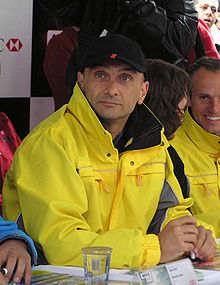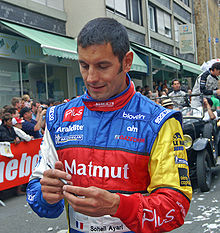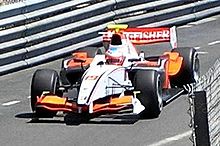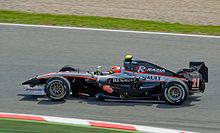Paolo Coloni Racing
Paolo Coloni Racing is an Italian motorsport team from the Umbrian municipality of Passignano sul Trasimeno near Perugia , which was founded in 1982 by Enzo Coloni under the name Enzo Coloni Racing Car Systems . In later years it operated under the name Coloni Motorsport , at times also as Scuderia Coloni . It is now run by Paolo Coloni , the founder's son. The team has been involved in various motor sport classes since 1983, including Formula 3 , Formula 3000 , the GP2 series and temporarily also Formula 1 . From 2006 to 2009, the team competed in the GP2 series with the support of the then Formula 1 driver Giancarlo Fisichella under the name Fisichella Motor Sport International . Scuderia Coloni has stopped racing regularly since 2013.
From 2006 to 2016 Coloni organized the Auto GP series. The company has been running a racing driver school in Passignano sul Trasimeno since July 2017.
history
The founder of the racing team was Enzo Coloni, born in 1946, who was active as a racing driver in smaller motorsport classes for ten years from 1973. In 1976 Enzo Coloni started racing in the Italian Formula 3 series. In 1981 he won his first Formula 3 races in a March 813, finishing the season fourth, and in 1982, at the age of 36, won the Italian Formula 3 championship. Coloni was rarely involved as a driver in higher motor sport classes; only in 1980 and 1983 did he contest a race in the Formula 2 European Championship . The results achieved there were not enough to gain a foothold in Formula 2 from 1983. Therefore, he decided to set up his own racing team in the future and to use his experience in team management.
The team's activities were distributed as follows:
- 1983 to 1987, 1991 to 1996 and 2003 to 2005: Italian Formula 3, alongside at times European Formula 3.
- 1986 and 1997 to 2004: Formula 3000
- 1987 to 1991: Formula 1
- 2005 to 2012: GP2 series.
Formula 1
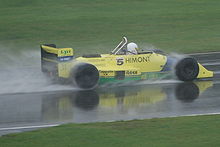
Coloni became internationally known primarily through his involvement in Formula 1 from 1987 to 1991. After a few years in Formula 3 and a single year in Formula 3000, the team had very quickly advanced to Grand Prix racing, where it did however, it should reach its financial and logistical limits. The sporting successes that Enzo Coloni had achieved in smaller classes should remain unattainable here. In fact, the results were sobering. Between autumn 1987 and autumn 1991 Coloni competed in 82 races. During this time, the team was only able to qualify for 14 races, and there were only five finishings in total, all of which were recorded in 1988. The last race participation took place in autumn 1989 in Portugal; In the following two years Coloni should not even qualify for a race. With this statistic, Coloni fits into the ranks of the most unsuccessful teams in Formula 1 history.
The main reason for this was a permanent and blatant lack of money. As a small Italian team, it was difficult or even impossible to find international sponsors. On the other hand, in the late 1980s, Ferrari , BMS / Dallara , Coloni, EuroBrun Racing , Minardi and Osella drove no fewer than six Italian teams in Formula 1, all of which were looking for national sponsors. At this time Coloni was the smallest team with the weakest infrastructure. There was soon a lack of material and personnel; Time and again there were phases in which the team only consisted of half a dozen employees - a fraction of the people employed in a top team. Again and again one had to improvise; technical solutions could no longer be developed or even implemented. Enzo Coloni later stated that his years in Formula 1 were the only time he was financially up to his neck.
The Italian Formula 3
While Formula 1 was an ambitious project of the team founder and quickly made the racing team internationally known, Formula 3 - especially the Italian racing series - was an essential pillar of Coloni for decades. Coloni was a constant here and was always good for success. Enzo Coloni cultivated his relationships with this racing series, which meant a lot to him personally. Even if Coloni temporarily competed in higher racing classes, Formula 3 was mostly operated in parallel, even when other operations suffered from a considerable lack of money and the existence of the company was in danger. That was the case, for example, in 1991, when Coloni's Formula 1 project was on extremely shaky legs. After the collapse of the Formula 1 team at the end of 1991, Formula 3 was an almost natural retreat for the company and enabled Enzo Coloni and his son Paolo to re-establish themselves in motorsport.
1983
In its first season, the young team competed in Italian Formula 3 alone. As early as 1983 Coloni's driver Ivan Capelli dominated the national championship with a Ralt RT3 Alfa Romeo, winning nine of 13 races.
1984
A year later, Coloni was already driving two tracks: In the Italian Formula 3 championship, the team fielded a car for Alessandro Santin, who won four races and took home the national championship title. At the same time, Ivan Capelli drove a Martini Mk45 for the Coloni team in the European Formula 3 series, in which he also achieved several victories.
1985
In 1985 Alex Caffi drove for Coloni's Formula 3 team in the Italian championship; the young Italian just missed the championship title.
1986
1986 Coloni Motorsport served the Italian Formula 3 and the European Formula 3000. Coloni's fourth season in the Italian Formula 3 championship was a successful year. The team used two current Dallara cars with Alfa Romeo engines . Coloni's driver Nicola Larini won five times and clearly won the championship with 69 points. The runner-up also came from Coloni's racing team: Marco Apicella scored 62 points with three wins and a total of ten podium finishes.
1987
Coloni Racing fielded two Reynards with Volkswagen engines for Antonio Tamburini and Rinaldo Capello. Overall, the team could not build on the successes of the previous year. There were no wins and only a few podium positions. Capello was the better driver. He reached ten championship points and finished the year in eighth place. Tamburini received eight points and was tenth. The championship title this year went to Enrico Bertaggia, who drove for Forti Corse and scored 53 championship points. At the end of this year, Coloni temporarily stopped his activities in Formula 3; the team was fully occupied with its Formula 1 involvement.
1991
After three years of interruption, Coloni Motorsport appeared again in the Italian Formula 3 in 1991. The team fielded two Ralt RT35s with Alfa Romeo and later with Volkswagen engines. The first driver was the 21-year-old Paolo Coloni, the son of Enzo Coloni, who made his Formula 3 debut here. Paolo Coloni achieved 15 championship points and finished eighth in the end of the year. Gianmaria Leonetti, who did not achieve any championship points, drove next to him. It is noteworthy that Paolo Coloni was named as the official test driver for Coloni's Formula 1 team in the same year. It has not been proven whether he actually moved the Coloni C4.
1992
In 1992, Enzo Coloni's team focused solely on Italian Formula 3 . Coloni Motorsport competed with a vehicle that they had developed and built themselves. The car was named "FTS 392" after a sponsor. Coloni Motorsport was the only team that fielded this car, and it was also the only team that ever competed with a self-built car. This was in tough competition with Dallara , whose cars dominated the Italian Formula 3. Of the 24 teams, 16 used Dallara cars right from the start, while seven teams used Ralt cars . Of these seven, five more also moved to Dallara during the season. Coloni's drivers were again Paolo Coloni and Giancarlo Grieco. During the season, Paolo Coloni only moved the AGV, although after some initial use with Alfa Romeo engines, Mugen engines were later switched to. He scored one point with the car and finished the season in 23rd place. His team-mate Grieco also switched from the AGV to a Dallara during the season. However, he did not reach a single point.
1993
For the coming year Coloni Motorsport handed over the AGV vehicles, now called 923, to the Italian Apex team. There they were moved by Sandro Corsini, Paolo de Cristofaro and Cesare Manfredino without any of the drivers being able to reach a championship point.
Coloni Motorsport, on the other hand, used a single Dallara 393 for Paolo Coloni, which was initially powered by an Opel and later by a Fiat engine. Paolo Coloni reached 23 championship points and finished the season in seventh place. It was the last year that Paolo Coloni took part as an active driver in a race for the Coloni Motorsport team. Paolo Coloni took over the management of the family racing team, supported by his father.
1994
In 1994 Coloni Motorsport again ran two cars, in both cases Dallara 394s with Fiat engines. Drivers were Gianluca Paglicci, who ultimately finished fifth of the season with 150 points, and Alberto Pedemonte, who scored 38 points and finished the season in eleventh.
This year three FTS racing cars appeared again; They were reported by the GPSR team as FTS 933. The drivers were Davide Amaduzzi, Enea Carta, Paolo de Cristofaro and Gianluca di Lorenzi. None of them could achieve a single championship point.
1995
Gianluca Paglicci stayed in the team for the next season, with Danilo Tomassini as his partner. The cars were current Dallara cars (395). Fiat engines were used as engines, and at Paglicci they were later replaced by Alfa Romeo engines. Paglicci was fourth in the championship with 131 points, Tomassini reached 13 points and finished the season on 18th.
1996
1996 was to be the last year in which Coloni Motorsport was involved in Italian Formula 3. The team used Dallara 396 cars with Alfa Romeo engines . The team's most successful driver was the Argentine Esteban Tuero , who finished the season 13th with 16 points. Tuero was to contest a Formula 1 season for the Minardi team in 1998 . His team mate Marco Barindelli did not score a championship point. Much looked as if Coloni had already been busy preparing for the 1997 Formula 3000 race during the season and was not paying too much attention to Formula 3.
2003
After a six-year break, Coloni appeared again in the Italian Formula 3 championship in 2003 - parallel to his involvement in Formula 3000. The team was reported under the name Coloni F3. Coloni continued only team a Lola - Dome a race car that was powered by a Mugen-Honda engine. All other teams used Dallara cars . The drivers were Christian Montanari from San Marino and Marco Bonanomi from Italy . Montanari was extremely successful: this year he only missed the championship title by four points and finished the year in second place with 98 points. Bonanomi reached 77 championship points and finished fourth.
2004
In the following season Coloni - still the only team - kept the Lola racing cars, but switched to Opel engines . The driver was Toni Vilander from Finland. He was the dominant man of the season: out of eleven races he won six. At the end of the year he had achieved as many championship points as Matteo Cressoni, who drove for the Ombra team; nevertheless, Cressoni, who, unlike Vilander, had contested all races of the season, was awarded the championship title. Coloni's second husband was Alex Ciompi; he finished the season in third place overall.
2005
In 2005 Coloni F3 dropped significantly. The three-year-old Lolas had no chance against the current Dallara 304. The best Coloni driver was Riccardo Mari, who scored a total of ten championship points and finished the season in 12th place. For comparison: the champion of the year, Luigi Ferrara, who drove a Dallara for the Corbetta team, had achieved 180 championship points. Coloni's second driver, Giaccomi Piccini, only scored four championship points. After that year Coloni ended his Formula 3 involvement again.
The Formula 3000 (1986; 1997-2004)
Coloni's Formula 3000 commitment is divided into two phases. A short-term assignment in 1986 should initially be a preparation for the upcoming Formula 1 participation. From 1997 the company took part in Formula 3000 regularly and with serious commitment. The engagement was not easy. The racing team, which was now run by Paolo Coloni, had to struggle through some tough years. From 2002, however, the team was able to compete for victories, and it became a permanent fixture in the Formula 3000 circus, which temporarily operated two racing teams at the same time.
1986
In 1986, after three years in Formula 3, Enzo Coloni ventured into the next higher class of international motorsport: In parallel to the Formula 3 team, which was initially still in operation , Coloni now also competed in Formula 3000 , which this year was in her second season went on. In every race the team fielded a used 1985 March 85B for Gabriele Tarquini , who finished fourth at the Imola race and even third at the Österreichring . Mostly a second car (also a March 85B) was used, on which various Italian drivers tried their hand at: Franco Forini from Ticino in Vallelunga, Guido Daccò at the races in Imola and Mugello , Nicola Larini in Enna, Alessandro Santin on the Österreichring and in Birmingham as well as Nicola Tesini in Le Mans and Jarama . However, none of them achieved Tarquini's results. Your assignments are more likely to have served to develop further financial resources for the team.
In 1987 Coloni was no longer involved in Formula 3000 (but in Formula 3). The main focus of the company was clearly on preparing for the upcoming Formula 1 race.
1997
After a ten-year hiatus, Coloni returned to Formula 3000 in 1997 . Behind the company lay the collapse of its Formula 1 involvement and a slow rise again in Italian Formula 3. Markus Friesacher and Emiliano Spataro were hired as drivers for Formula 3000 . The drivers could not qualify for every race and never made it into the top ten in the race. Coloni Motorsport celebrated a first sense of achievement at the last race of the season in Jerez . Oliver Tichy , who replaced Spataro for this race, finished second and scored both the first points and the first podium finish for Coloni Motorsport in this motorsport class.
1998
In 1998, four different drivers drove for Coloni with Giorgio Vinella , Thomas Biagi , Rui Águas and Oliver Tichy. Apart from Biagi, who finished fourth in the opening race in Oschersleben , none of the drivers could score points for Coloni Motorsport.
1999
The 1999 season began Coloni Motorsport with the drivers Polo Villaamil and Norman Simon , both of whom often failed in qualifying. Simon was replaced after seven races by Marcello Battistuzzi and Dino Morelli , who both always qualified for the race. No driver was able to score points throughout the season.
2000
Soheil Ayari and Fabrizio Gollin were signed for the fourth season that Coloni Motorsport contested in Formula 3000 . Both drivers managed to score points and Gollin brought the team to the Nürburgring second place on the podium in this championship. Ayari left the team with three races to go and was replaced by his compatriot Fabrice Walfisch . In the team standings, Coloni Motorsport finished tenth overall.
2001
Coloni Motorsport continued its Formula 3000 involvement in the 2001 season. In addition to Gollin, who remained in the team as a driver, Rodrigo Sperafico was signed . For the last three races, Sperafico was replaced by Marc Goossens, who, unlike his predecessor, scored points. In the overall standings, Coloni Motorsport finished twelfth at the end of the season.
2002
In 2002 Coloni Motorsport took part again with two teams in Formula 3000. Enrico Toccacelo and Giorgio Pantano competed for Coloni . The driver combination turned out to be a stroke of luck for the team: After Pantano scored the first victory for Coloni Motorsport in Barcelona , three more victories followed, two from Pantano and one from Toccacelo. In the team standings, Coloni won the runner-up title behind Arden Team Russia . In the drivers' category, Pantano won the runner-up title behind Sébastien Bourdais .
In spring 2002 Coloni took over the competing racing team European Minardi F3000, which was an offshoot of the Formula 1 team Minardi . Paul Stoddart, the owner of Minardi, took over the established F3000 racing team Edenbridge Racing in 1999 and started it in 2001 under the name of his Formula 1 team in the Formula 3000. After a little over a year, Minardi's junior team got into economic difficulties, so that Stoddart had to end his Formula 3000 involvement. After initially considering a sale to Astromega, a cooperation with Coloni was announced on the occasion of the race at the Nürburgring, which was an economic takeover. For the last races in 2002 Coloni then ran two racing teams; until the end of 2002 the second team kept the name European Minardi F3000. However, after the takeover by Coloni, the season was not more successful than in the first races: The team finished tenth overall with no points at the end of the season.
2003
In 2003 Coloni's second team, the former European Minardi F3000 team, became the Red Bull Junior Team F3000 . Zsolt Baumgartner and Ricardo Sperafico started for Coloni's own team . With Sperafico, they once again had a driver on the team who was able to compete for victories and who won the races in Zeltweg and Hockenheim . Baumgartner left the team, although he had only scored a few points, for his home race in Budapest towards Formula 1 for the Jordan team. At the season finale he was replaced by Christian Montanari . In the team standings you had to admit defeat to your own competition again. The Red Bull Junior Team finished second in the team standings with Patrick Friesacher's victory . Coloni finished fourth and again won the runners-up title with Ricardo Sperafico.
2004
Jeffrey Van Hooydonk and Can Artam drove for Coloni Motorsport . During the season, both drivers were replaced by Patrick Friesacher and Chanoch Nissany . Friesacher, who had already won a race for the second Coloni team a year earlier, scored the only victory for Coloni this season. The second team was renamed CMS Performance after Red Bull withdrew as a sponsor in 2004 . In the team classification, CMS Performance, which started with José María López and Mathias Lauda , came fourth ahead of Coloni, who came fifth.
The GP2 series (2005–2012)
2005
After the discontinuation of the International Formula 3000, Coloni switched to the successor series GP2 in 2005 . Mathias Lauda stayed with the team, and the team was strengthened with the former Formula 1 driver Gianmaria Bruni . Three races before the end of the season, Bruni, who won the main race in Barcelona and finished second in Monaco , left the team and was replaced by Toni Vilander and Ferdinando Monfardini . In the team classification, the team finished ninth overall.
In 2005 Coloni was in charge of Giancarlo Fisichella's team , Fisichella Motor Sport , which competed in the Italian Formula 3000 and won the championship with Luca Filippi .
2006
In 2006 Coloni Motorsport and Fisichella Motor Sport merged to form Fisichella Motor Sport International , or FSMI for short . Paolo Coloni had signed an agreement with the Formula 1 driver Giancarlo Fisichella, who, parallel to his involvement in Formula 1, used cars with his own name in smaller racing classes. The use in the GP2 was organized by Coloni Motorsport. Fisichella gave the money and his name, while Coloni did the day-to-day business. In addition to the GP2 series, the team took part in the Italian Formula 3000 series.
In the GP2 series, in which FSMI was sponsored by Petrol Ofisi , Giorgio Pantano was able to achieve a respectable fifth place overall. He won one of the two races at Magny-Cours and both races on his home circuit in Monza . Pantano replaced the somewhat disappointing Luca Filippi, whose best result with the team was a fifth place in Imola . Filippi switched to BCN Competición after the first three race weekends , where he replaced Timo Glock , who in turn had switched to iSport International . The second driver, Jason Tahincioğlu from Turkey , had a bad year, his best finish was an eleventh place in Monza. In the team classification, FSMI came fifth overall.
2007
At the start of the 2007 season in the GP2 series, the team expected an upward trend after last year's fifth place, especially since Antonio Pizzonia, a driver with Formula 1 experience, had been signed. However, Pizzonia turned out to be a disappointment as he only managed to score a single point at the Monaco race. He was replaced by Adam Carroll from the fourth race weekend . Caroll won the home race at Silverstone and the Hungaroring. Three more podium places followed and he finished seventh overall. Jason Tahincioglu never reached a top 10 position in any race and disappointed again. In the overall standings, the team finished ninth.
2008
At the beginning of the year FSMI took part in the first season of the GP2 Asia series with Adrián Vallés and Michael Herck . After Herck was injured, he was replaced by Roldán Rodríguez in the last race of the season . In the overall ranking, the team took seventh place.
The team originally planned for the GP2 series with Spanish drivers Andy Souček and Adrián Vallés, but both were replaced around the first race weekend in Barcelona. Roldán Rodríguez took over the cockpit from Souček before the start of the first race. A short time later, Vallés switched to the BCN Competición team and was replaced by Adam Carroll. After the race in Monaco, the team separated from Carroll and awarded the second cockpit place to the Estonian Marko Asmer . In the overall ranking of the 2008 season it was only enough for tenth place.
2009
Before the start of the 2009 season, they took part again in the GP2 Asia series . Andreas Zuber and Kevin Nai Chia Chen were signed as drivers . After it became clear that Zuber should also drive in the regular GP2 series for FSMI, he was replaced by Rodolfo González . During the entire season, none of the drivers made it into the points and thus finished twelfth in the team standings.
In the European GP2 series, the team started with Zuber and Luiz Razia . While Razia has not yet been able to get any points, Zuber has already achieved three podium finishes. During the 2009 season, Giancarlo Fisichella parted ways with Coloni Motorsport. Paolo Coloni took over Fisichella's shares and led the GP2 racing team entirely on his own again from the Valencia race. The team was renamed - in view of the new main sponsor - in Party Poker Racing Scuderia Coloni . All of FSMI's racing activities were affected by the agreement.
The team hit the headlines again at the race in Spa-Francorchamps . As a result of a legal dispute with Andy Souček, who had been dismissed with a contract a season earlier and has since asked Coloni to repay the payments he had already made, the Scuderia Coloni racing cars were confiscated. After the last race of the season, Coloni again finished tenth in the team classification with 29 championship points.
2010
In the 2010 season, the alliance with the previous main sponsor was not continued. The team started under the name Scuderia Coloni . The vehicles were painted silver and had black and red accents. The drivers were the Brazilian Alberto Valerio and the Bulgarian Vladimir Arabadzhiev . For the last two races of the year in Monza and Abu Dhabi, Arabadzhiev was replaced by New Zealander Brendon Hartley . Coloni scored a total of 18 points in 2010 and finished tenth in the team classification.
2011
In the seventh season of the GP2 series, Coloni started with drivers Michael Herck and Davide Rigon . In the sprint race in Istanbul, the first run of the year, Rigon collided with his competitor Julian Leal . In the accident, Rigon suffered numerous fractures of the fibula, which meant that he would not be able to race for several months. Rigon was replaced by the 17-year-old Kevin Ceccon for the following races . The first races of the year were unsuccessful. Halfway through the season Coloni was only able to book one championship point (won by Herck in the sprint race in Spain). So it was in the team standings on the penultimate place.
The situation improved when Coloni replaced Ceccon with the Italian veteran Luca Filippi for the race at the Nürburgring in July . Filippi won the main race on his first appearance for Coloni and finished the sprint in third place. Filippi won again in the final race in Monza; he also won the sprint race in Belgium. Overall Filippi was runner-up behind Romain Grosjean with 44 points ; Herck was 21st with two points. Coloni finished the European 2011 season in seventh place in the team ranking.
2012
In 2012 Coloni competed in the GP2 series with Stefano Coletti and Fabio Onidi . The team's best result was achieved by Coletti, who finished the race in third place. In July 2012, Enzo Coloni declared without giving any reason that his team would no longer participate in the 2013 GP2 season. The Scuderia Coloni were then stripped of all championship points for the 2012 season.
Auto GP
Since 2006 Coloni has also organized the Auto GP racing series , a motorsport class that emerged from the European Formula 3000 championship. Up until 2014, eight to ten races were held annually, in which various Italian and European teams took part. Coloni himself was represented in the Auto GP with his own racing team until 2012.
In 2015 the series lost its attractiveness. After only two races, the championship was ended prematurely, as the starting field had meanwhile fallen below ten cars. In 2016 Coloni tried again to organize a championship. After the first race, in which only four teams and a total of seven drivers had participated, Coloni gave up the independent implementation of the series. The remaining teams and drivers started in the Boss GP series since July 2016 , in which there was still an independent evaluation of the Auto GP. Coloni planned a new version of this concept for 2017. However, only the 18-year-old Indian Mahaveer Raghunathan stayed with Coloni, so that this year he was the only racing driver to start under the AutoGP label. In 2018 Coloni no longer takes part in motorsport competitions.
further activities
In addition to running their own racing team, Enzo and Paolo Coloni were also active in the organizational field of racing and also temporarily produced chassis for regional racing series.
For the Euro Open by Nissan , Coloni developed the standard chassis used from 1998. Coloni was the exclusive manufacturer of the vehicles at this time.
Racing school
After the AutoGP series was effectively discontinued, Coloni opened the Scuola Piloti Coloni Motorsport racing school in July 2017 . It operates from Passignano-sul-Trasimeno. The practical missions are to be carried out at the Autodromo dell'Umbria in Magione .
Web links
Individual evidence
- ↑ Motorsport aktuell, issue 26/2002 and 27/2002
- ↑ Asmer gets the free FMSI cockpit motorsport-total.com on June 11, 2008
- ↑ Confiscated: Coloni in Spa not starting motorsport-total.com on August 28, 2009
- ↑ "Numerous breaks: Rigon threatens a six-month break". See news from May 11, 2011 on the website www.motorsport-total.com .
- ↑ "Coloni: No Future in GP2". News from July 6, 2012 on the website www.motorsport-total.com .
- ↑ Message on the website www.autogp.net from July 2, 2017 (accessed July 10, 2017) .

